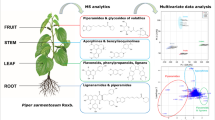Abstract
Seven alkaloids were isolated from the seeds of Ammopiptanthus mongolica by thin layer chromatography and silica gel column chromatography, and the chemical structures of five alkaloids, 17-oxosparteine, β-isosparteine, 3α-hydroxysparteine, sparteine, and 3β-hydroxysparteine were identified by 1H nuclear magnetic resonance (NMR) and electron ionization mass spectrum (EIMS).
Similar content being viewed by others
References
Dou J H, Lee J S, Yan W M (1989). Study of alkaloids in Euchresta japonica. Traditional Chinese medicine journal of China, 14(5): 41–44 (in Chinese)
Fu K J, Zhang Z W, He S B (1993). Flora of China, Volume 41. Beijing: Science Press (in Chinese)
Fu L G (1989). Rare and endangered plants in China. Shanghai: Shanghai Education Press, 183–184 (in Chinese)
Jia H X, Sun X G (2005). Atlas of Halophytes in Northwest China. Beijing: China Forestry Press, 48 (in Chinese)
Li C L, Yu Q S, Li A D (2004). Study and application of the endangered plant Ammopiptanthus. Chinese Wild Plant Resources, 23(5): 21–23 (in Chinese)
Liu J Q, Qiu M X, Yang K, Shi Q H (1995). Studies on the plant community of Ammopiptanthus mongolicus. Journal of Desert Research, 15(2): 109–115 (in Chinese)
Ma Y Q (1989). Flora of Inner Mongolia (Volume 2). Huhehaote: Inner Mongolia People’s Publishing House, 2: 190 (in Chinese)
Murakoshil I, Fukuchi K, Haginiwa J (1977). N-(3-oxobutyl) cytosine: A new lupin alkaloid from Chinosophora koreensis. Phytochemistry, 16(9): 1460–1461
Ning Y C (2000). Structural Identification of Organic Compounds and Organic Spectroscopy. Second Edition. Beijing: Beijing Science Press (in Chinese)
Wei Q H, Zhao B G (2000). Alkaloids of Thermopsis laceolata-R Brown and their biological activities. Journal of Nanjing Forestry University, 24(5): 73–76 (in Chinese)
Wu Y, Geriletu B (2004). New extraction ways for preparation of cytosine. Journal of Inner Mongolia Normal University, 33(2): 186–187 (in Chinese)
Xu G Y, Pan B R, Xie M L (1994). A study on the alkaloids of Ammopiptanthus mongolicus. Pedology and Desert Research, 11(1): 50–52 (in Chinese)
Yu D Q, Yang Q S, Xie J N (1989). Handbook of Analytical Chemistry, Vol 5— NMR Analysis. Beijing: Chemical Industry Press, 583–595 (in Chinese)
Zhang L Z, Li J S (1997). Alkaloids in Sophora alopecuroides seed and relevant tests for activity. Traditional Chinese Medicine Journal of China, 22(12): 740–743 (in Chinese)
Zhao B Y, Ruan N, He S H (2004). The extraction, isolation and identification of alkaloids from Thermopsis lanceolata. Progress in Veterinary Medicine, 24(4): 87–89 (in Chinese)
Author information
Authors and Affiliations
Additional information
__________
Translated from Journal of Lanzhou University (Natural Sciences), 2007, 43(2): 43–46 [译自: 兰州大学学报(自然科学版)]
Rights and permissions
About this article
Cite this article
Xiao, W., Jia, H. Analysis of sparteines in the seeds of Ammopiptanthus mongolica . Front. Biol. China 3, 459–462 (2008). https://doi.org/10.1007/s11515-008-0091-1
Published:
Issue Date:
DOI: https://doi.org/10.1007/s11515-008-0091-1




